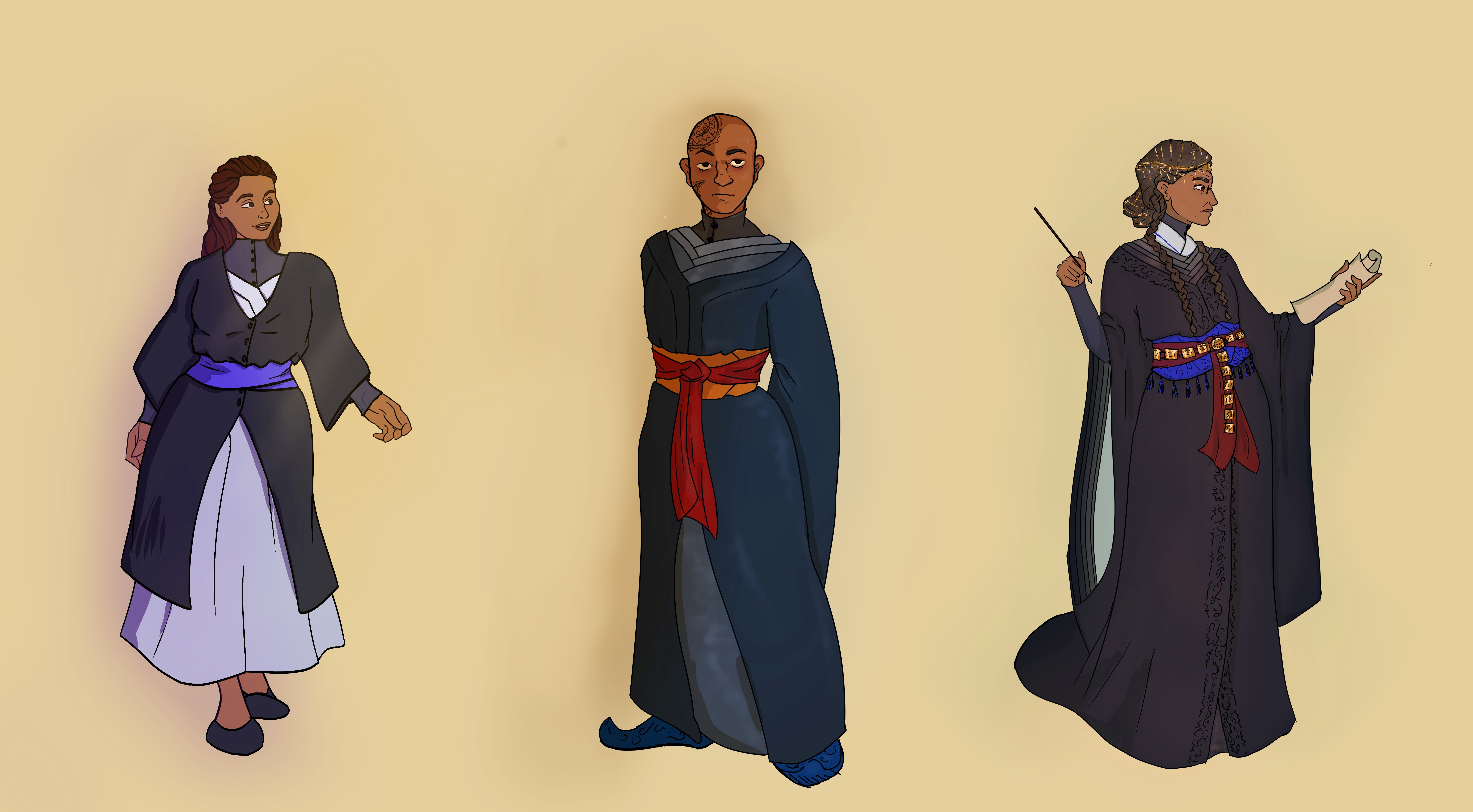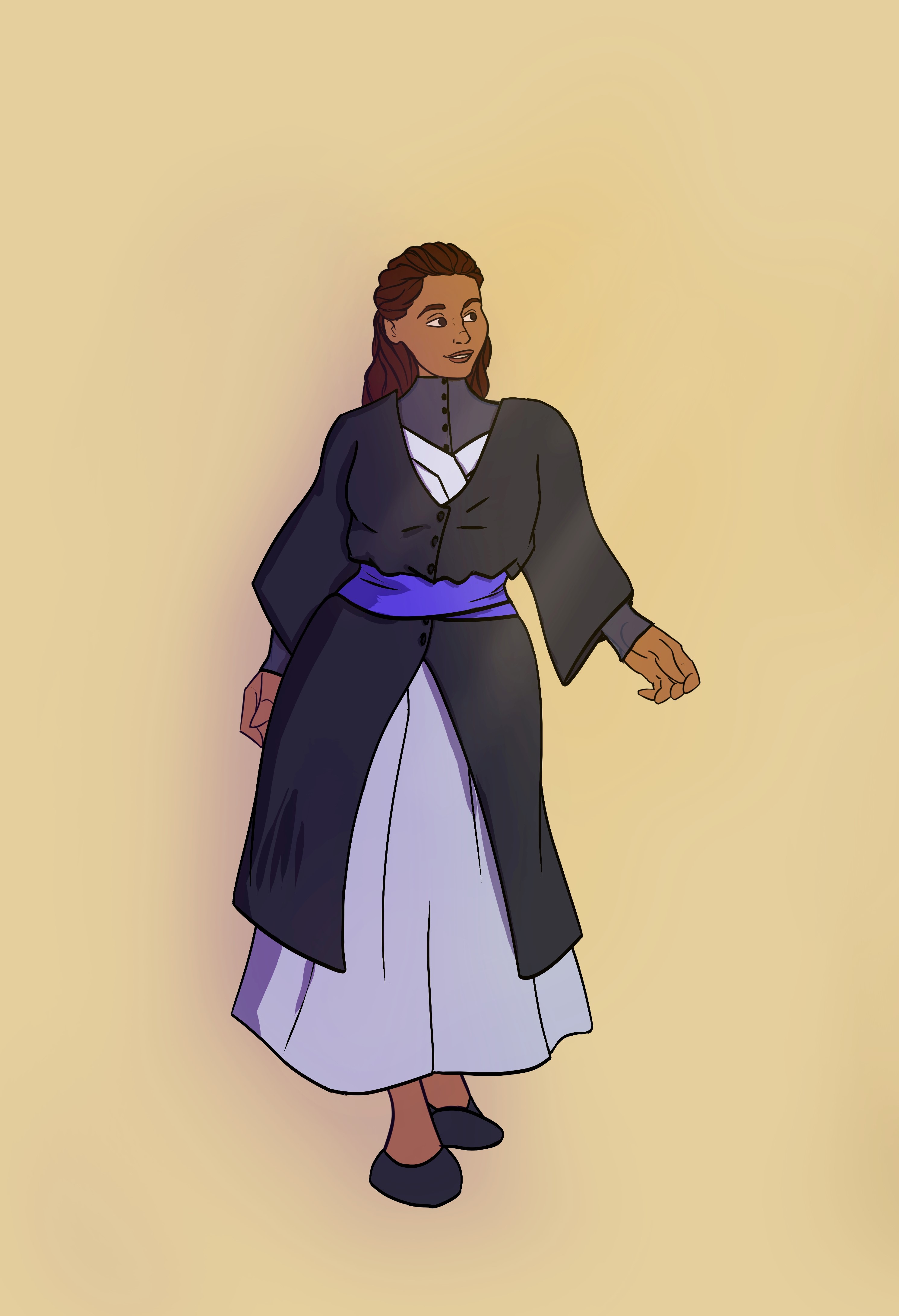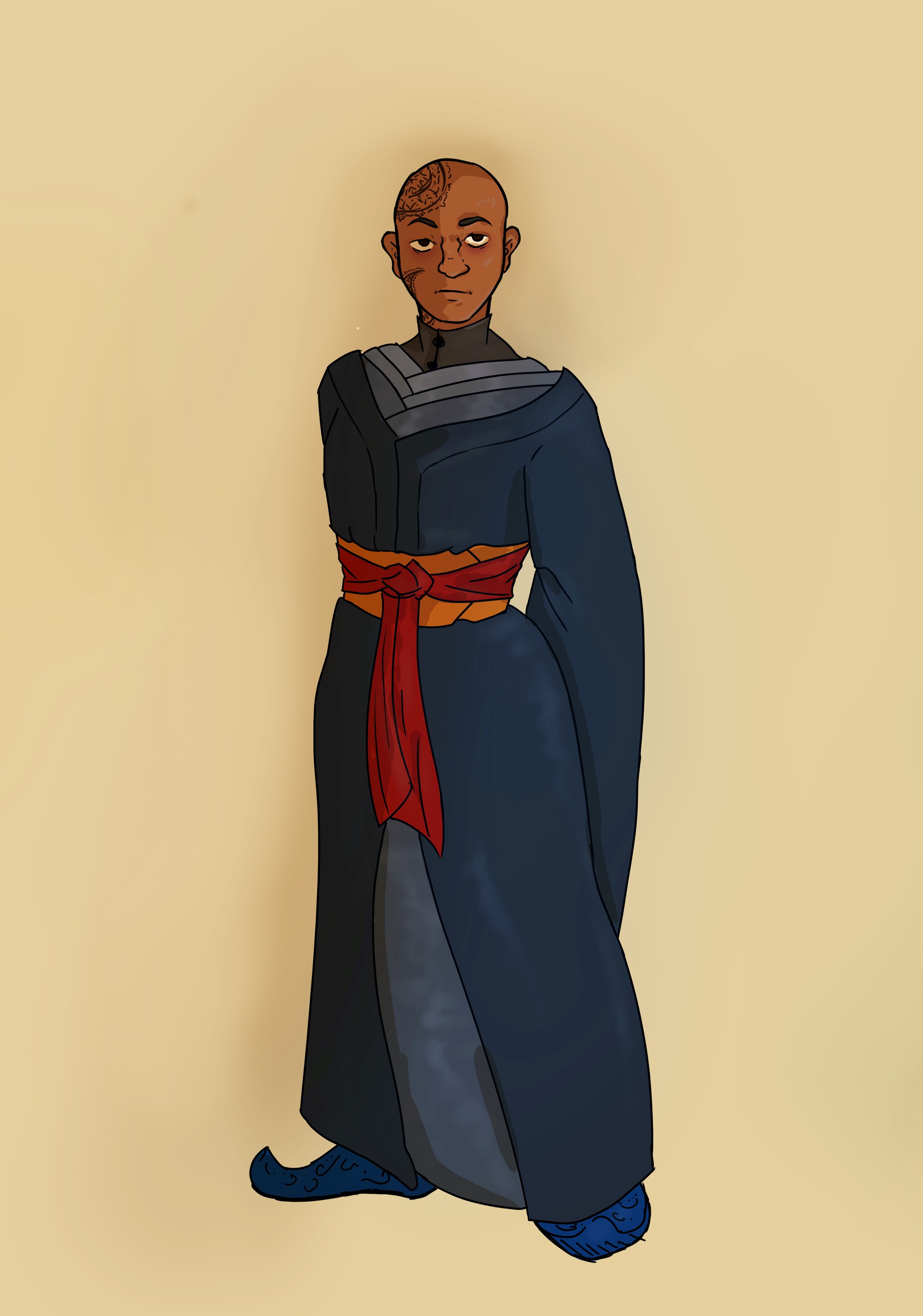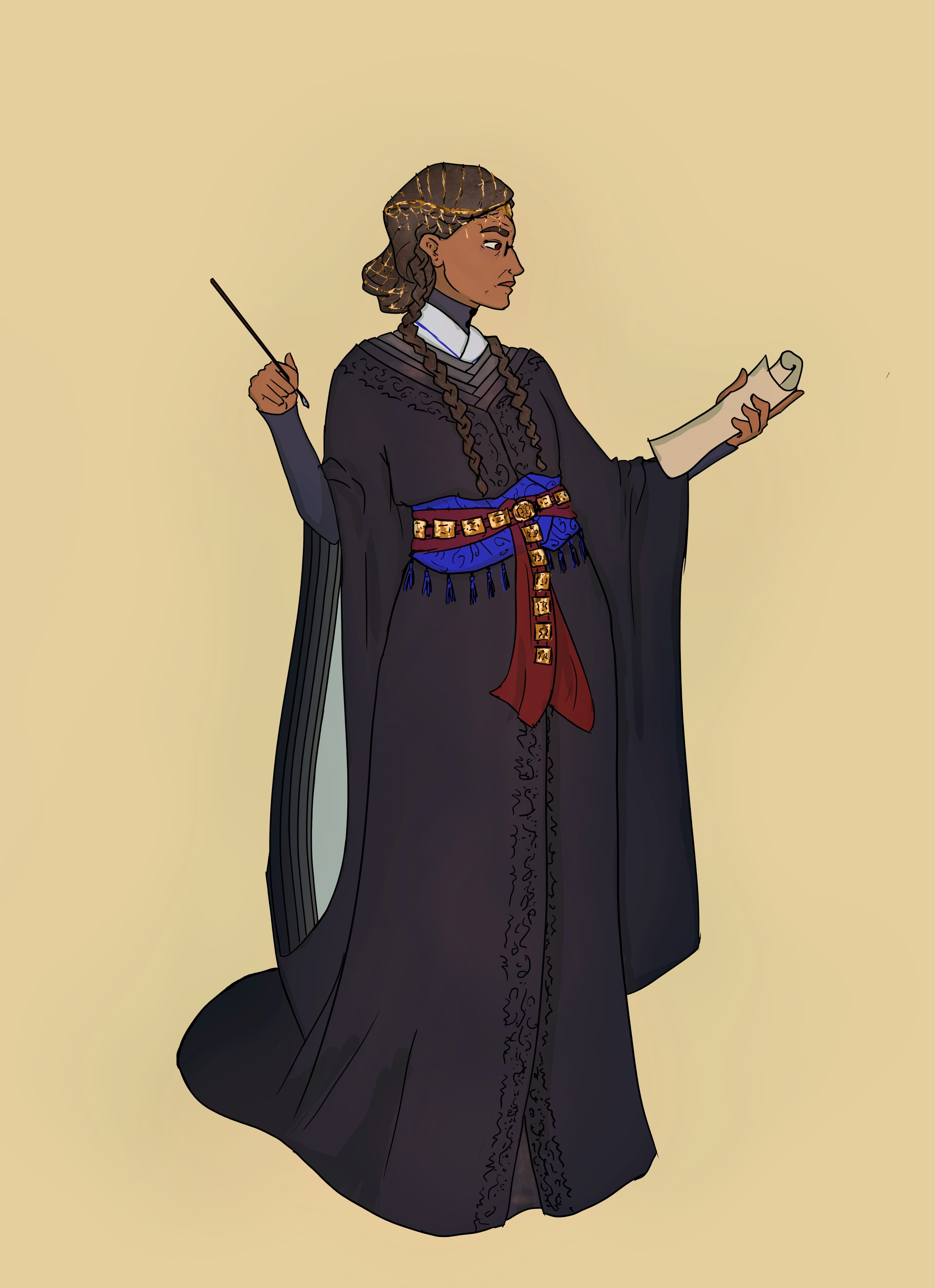Academic Robes
Traditional wear at the Acacemy in Brixilian
The most respected of the Academy members would be the Faculty Leaders, who are also a part of The King’s Council. These have the most layers in their attire and are easily recognizable by the traditional style of their attire.
Layering, fabrics, and meaning
The following will describe the design of each layer in the academic robes, as well as the meaning of each layer, and who is allowed to wear these layers.The description will start with the outermost layers, these are worn by most of the attending and working at the academy, the inner layers are a symbol of achievement and progress in one’s education at the academy. The layers in this discription will be the zona; discentem vesti; vesti; scienta; and at last the vesti occulo.
Zonae
All the robes are worn atop of each other, in a kimono-like fashion, to keep these in place a belt is tightened across the middle, this belt is called a zona. It is worn by all attending or researching at the academy; however, the zona change design according to position in the academy.A zona represents the wearers chosen field of study – the faculty of which they are enrolled. In total four different types of zonae exist:
the student’s zona; the scholar’s zona; the doctor’s zona; and the zona worn by the Faculty Leaders. The first zona will be the student’s zona, worn and used by newly enrolled students at the academy, and not changed until the last of their exams in their field of study. It is no more than eight centimetres wide and must be long enough for the wearer to wrap it two and three-quarters of times around their middle. Furthermore, it is succoured with a pin, to hold the belt in place.
The belt is made of thick and sturdy cotton, which is coloured to match the faculty of which they belong.
It is important to note that the new student themselves are responsible for the garments they are required to wear, the academy does NOT provide the students with their attire. A student must pay for their clothes themselves and further provide for the caretaking of their garments.
When a student has passed all their exams and has officially graduated, they are gifted – by the academy – their scholar’s zona. Not all, and definitely not many, students pass their final exams, and it is seen as an honour and privilege to the name of the academy when students pass their exams.
The scholar’s zona is the second and first gifted zona in a scholar’s career.
This zona will have a more structured body and shape to it and is closed with a pin or clasp. The scholar’s zona is shaped to have a wide back and shaped front. For reference see the illustration of the zonae.
The scholar’s zona is made up of fashion fabric, the outer fabric which will be visible, and a lining layer. The fashion fabric will be of thick silk satin, coloured brightly in the corresponding field of study, and the lining layer of medium-thick cotton – in a more modest colour, usually undyed. The third and second to last of the zonas are the doctor’s zona. This will be gifted, in exchange for the scholar’s zona when a scholar has written their first independent thesis, completed their masters and published an independent study, which they created, researched, and finished.
It is no easy job getting the doctor’s zona and only a handful of individuals researching at the academy currently have this position.
The fashion fabric for this zona is also made of thick silk satin, though of better quality, and the lining is made of sturdy taffeta silk – in a colour contrasting the fashion fabric. The zona is not closed with the former pin or clasp, instead, a shawl is tightened across it to keep the belt in place. It is bound artistically in front and secured in a way that neither shawl nor zona is bulky. The edge of the doctor’s zona is traced with silver thread to further elevate the status and importance of the wearer. Lastly is the Faculty Leader’s zona, and this is the most desired of all the belts. This is a zona worn by six of the most important and powerful individuals in Brixilian, and it is widely known they have earned the right to wear these belts.
The Faculty Leader’s zona is gifted by the previous Faculty Leader to the next Faculty Leader. The gifting of this zona is a ceremony in which all associated with the academy is expected to attend.
The fashion fabric is original Brixilian Silk brocade, unlike the other silk belts which are made of fabricated silk. The brocade is coloured in the faculty’s colour mixed with patterns of gold. The lining is also made of original Brixilian Silk, though this is taffeta instead of the brocade. From the bottom edge of this belt, tassels are strung to further decorate the belt – these are in the colour of the faculty which the zona represents.
This zona is tied together with a shawl, which is expected to be bound in a way that both shawl and belt lie flatly across the middle. It is common practice to also wear one’s Professor's Belt atop one's zona.
Discentem Vesti
The first and most outer layer, besides the zona, is the Discentem Vesti, worn by all members of the academy.This is a large kimono-like robe, made from thick black chirimen/crêpe silk and preferably lined with soft satin silk. This is a garment all members are expected to buy themselves, and therefore not all discentem’s are made from the same fabrics, depending on what the individual was able to afford.
Following the same graduation rules as the zona the discentem vesti also change appearance depending on position in the academy. These designs are not as strict as in the style of the zona, yet some styles and designs are expected of a member of the academy when they reach a certain position, usually scholar or the above. A student’s discentem vesti are allowed to be shorter in length than what is expected of the grades above. The minimum length of this garment is the midpoint of the calf.
Usually, a student would not have a discentem made of silk, and instead it would be made of wool and the lining could be made of linen or another cheap fabric.
When a student becomes more remarkable or earns money by doing chores at the academy, either as a scribe in the library, or simply house cleaning, they can earn enough money to buy a finer discentem.
This is the reason that older students and scholars usually have finer clothes than the younger, though younger students might also wear finer clothes depending on the wealth of the student’s family. The scholar, having proved themselves an attribute to the academy, are required to meet certain expectations and wear a specific style of discentem.
Depending on the scholar’s wishes the sleeves can be either long and square shapes or keep the sleek look of the student’s sleeves. The fabric must be chirimen silk and the lining cotton or linen, depending on personal style and preference.
The length of the garment must reach the floor, though it has become fashionable for is to end near the ankle. If the square sleeves are preferred these must be half the discentem in length. If the body of the discentem is 160 cm the sleeves must be 80 cm long – however, during modern fashion sleeves have been found shorter than the actual requirement.
When becoming a doctor one can wish to change discentem as well, however, it is not required. A scholor’s discentem is designed to uphold all the requirements a discentem can meet and there is no need for changing it.
Usually doctors tend to choose a more ‘old fashioned’ look than what their scholar discentem represented. They would change sleek sleaves to long and square as well as making the kimono reach the floor. Faculty Leaders are also expected to wear the discentem, though this is usually longer and larger than the other members’ of the academy. The back of their discentem have a train, and all the edges are embellished with embroidery or other decorations. The style of this discentem have changes a bit through the last years. Elder members of the faculty might wear a discentem with long square sleaves – much resembling the sleaves on a furisode kimono – and the younger have more tight fitted sleeves, a bit more like a usual robe.
Vesti
Below the discentem several layers might follow depending on the remarkable deeds and other accomplishments a person might achieve or do during their education and further research.All vesti share the same design, and only change in colour from one another. A vesti is worn beneath the disentem, and whenever one acquires a new vesti it is worn beneath the previous one.
The vesti, much like the discentem is shaped in the style of a kimono. Its sleeves can be either long and square or sleek, depending on the design of the discentem.
The length of the vesti should match that of the discentem. Furthermore, these layers are required to be coloured grey, but with a metallic shine to it, to make the robe appear silver.
The traditional fabric for these garments would be taffeta silk, and preferably a heavy and thick taffeta, to make sure the garment holds its shape. Usually, the taffeta chosen will be woven to change the shine of the fabric depending on the light, and angle from which one sees it – making the kimono appear more iridescent.
If one has ever worked with, or held, taffeta silk one would be aware of the amount of noise this fabric creates when moved. To accommodate for this noise the vesti will have a lining made of a soft linen to soften and mute the sound of the moving and shifting fabric.
The first vesti one acquires will be very dark in its colour, and almost match the black colour of the discentem. The second vesti will then be slightly lighter in colour, and so forth. The shifting brightness and darkness of these layers create a pattern when worn together. In traditional style only a couple of centimetres of the collar of the vesti will be visible when placed atop each other, finishing with the black discentem atop the metallic vestis.
The vesti is closed by folding the left side over the right and binding is with small ribbons at the side.
Scienta
Beneath the layers of vestis is the scienta. This layer is solely worn by faculty leaders and other members of the academy are not allowed to wear it – this would be illegal, and they would be prosecuted with forgery of academic knowledge and stolen valour.This garment is in the same kimonolike in fashion, with two large rectangle sleeves and an open front, however it must be white. The full length of this must reach the mid-ankle.
The scienta is made from chirimen/crêpe silk and is usually a bit lighter in weave than the layers atop it, because of this it is important for the structure of the kimono to have a lining of stiff and crisp taffeta silk – a bit thicker than the chirimin silk.
Tracing the open edges of the scienta is a wide hem, the same that creates the collar around the neck. The inner seam of this is decorated with thick coloured thread, or silk yarn, in a bright colour, to contrast the white – it is common custom that this inner seam should be coloured the same as one’s zona, the lining of the scienta can be either white or coloured. If a coloured lining is prefered it must be the colour of the zona.
Vesti Occulo
The inner most layer in this attire will be the vesti occulo. This is only meant as an undergarment, and therefore is not counted as an actual ‘layer’, and neither does it have any ornamental or decorative function in the attire. Furthermore, this layer carries no meaning for the wearer and is simply viewed as an undergarment.Despite of this, the styling of this garment is still very much important – if this undergarment does not follow the style described it is not counted acceptable, and the entire costume is deemed unusable. The vesti occulo is worn directly on the skin and is worn to protect the other more expensive layers from the skin. The vesti occulo is made of a light, soft linen, and due to the nature of the fabric fibres it ensures a healthier skin for the wearer – it transport the sweat from the skin, keeping the skin dry and clean, while reducing a, somewhat, unwanted sweat-smell.
This undergarment is usually dyed in a dark, nearly black, colour, and it is tightly fitted to the wearer. The sleaves are long and should slightly cover the first part of the hand – no more than half a centimetre, the neckline is high and should cover the throat.
To ensure a tight fit and make it possible for the wearer to get in and out of the garment a opening is found in the centre front, from the neck and down to mid-hip. This opening is closed with small cloth-covered buttons – the flatter the buttons the better, it would provide less bulk in the overlaying garments.
Although this is a very fitted garment, it is only fitted to the torso, hips, and arms, below the hips the side-seams of the vesti occulo is opened, to create slits in the side. This gives the entire garment a slight tabard-like look. The length of this undergarment is expected to reach mid-angle of the wearer.
Student's wear
Student's zona, in faculty colour
Discentem Vesti, in black
Vesti Occulo
Scholar's wear
Scholar's zona, in faculty colour
Discentem Vesti, in black
Vesti Occulo
At least one vesti, prefearably two Doctor's wear
Doctor's zona, in faculty colour
Discentem Vesti, in black and in traditional style
Vesti Occulo
Three vesti or more Faculty Leader's wear
Faculty Leader's zona, in faculty colour
Discentem vesti, in black and in traditional style
Scienta, white and traced with faculty colour
Vesti Occulo
At least three vesti, preferably six
Professor's belt, this is not a requirement
Beneath the discentem she is wearing a simple linen kimono-blouse, and a linen skirt - these are not a part of the Academic Robes, but worn to not be indecent and show too much of the vesti occulo.









Great article! I love the detail you added here and the differences for the clothes between all the tiers. You added some great art to go along with it as well which gives me a good idea how it looks. Good read! Found a small typo at 'finder clothes' :)
Thankyou for the very kind comment, I'm glad you liked the article - and I will get to that typo immediatly